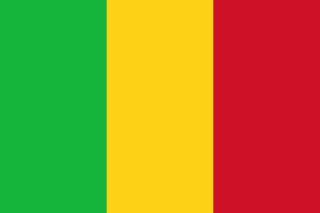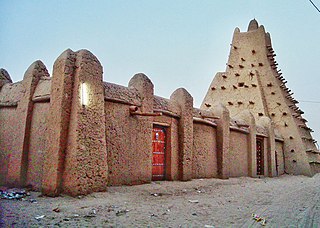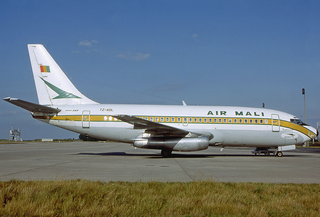
Mali, officially the Republic of Mali, is a landlocked country in West Africa. Mali is the eighth-largest country in Africa, with an area of just over 1,240,000 square kilometres (480,000 sq mi). The population of Mali is 19.1 million. 67% of its population was estimated to be under the age of 25 in 2017. Its capital is Bamako. The sovereign state of Mali consists of eight regions and its borders on the north reach deep into the middle of the Sahara Desert. The country's southern part is in the Sudanian savanna, where the majority of inhabitants live, and both the Niger and Senegal rivers pass through. The country's economy centres on agriculture and mining. One of Mali's most prominent natural resources is gold, and the country is the third largest producer of gold on the African continent. It also exports salt.

Mali's transportation infrastructure is regarded as poor, even by regional standards, and deficiencies have limited economic growth and development. Nevertheless, improvements have been noted in the early 2000s. Most of the transportation in Mali consists of cars, planes, and boats.

Bamako is the capital and largest city of Mali, with a 2009 population of 1,810,366. In 2006, it was estimated to be the fastest-growing city in Africa and sixth-fastest in the world. It is located on the Niger River, near the rapids that divide the upper and middle Niger valleys in the southwestern part of the country.

Timbuktu is a city in Mali, situated 20 km (12 mi) north of the Niger River. The town is the capital of the Timbuktu Region, one of the eight administrative regions of Mali. It had a population of 54,453 in the 2009 census.

Djenné is a town and an urban commune in the Inland Niger Delta region of central Mali. The town is the administrative centre of the Djenné Cercle, one of the eight subdivisions of the Mopti Region. The commune includes ten of the surrounding villages and in 2009 had a population of 32,944.

Mopti is a town and an urban commune in the Inner Niger Delta region of Mali. The town is the capital of the Mopti Cercle and the Mopti Region. Situated 630 km northeast of Bamako, the town lies at the confluence of the Niger and the Bani Rivers and is linked by an elevated causeway to the town of Sévaré. The urban commune, which includes both Mopti and Sévaré, had a population of 114,296 in the 2009 census.
Afel Bocoum is a musician from Mali, noted as a singer and guitarist. He began his career as a member of Ali Farka Touré's group ASCO, and Toure is often regarded as his mentor. Both men come from the town of Niafunke on the River Niger, and are members of the Sonrai people. Bocoum is an agricultural advisor by profession.

Azawad or Azawagh is the name given to northern Mali by Tuareg rebels, as well as a former short-lived unrecognised state (2012-2013).

Ibrahim Boubacar Keïta, often known by his initials IBK, is a Malian politician who served as the president of Mali from September 2013 to August 2020, when he was forced to resign in the 2020 Malian coup d'état. He served as Mali's prime minister from February 1994 to February 2000 and as president of the National Assembly of Mali from September 2002 to September 2007. Keïta founded the centre-left political party Rally for Mali (RPM) in 2001. After a number of unsuccessful campaigns, he was elected president in the 2013 presidential election and reelected in 2018. He resigned on 19 August 2020, after being taken captive by mutinous elements of the Malian Armed Forces.
Malick Sidibé was a Malian photographer noted for his black-and-white studies of popular culture in the 1960s in Bamako. Sidibé had a long and fruitful career as a photographer in Bamako, Mali, and was a well-known figure in his community. In 1994 he had his first exhibition outside of Mali and received much critical praise for his carefully composed portraits. Sidibé's work has since become well known and renowned on a global scale. His work was the subject of a number of publications and exhibited throughout Europe and the United States. In 2007, he received a Golden Lion Award for Lifetime Achievement at the Venice Biennale, becoming both the first photographer and the first African so recognized. Other awards he has received include a Hasselblad Award for photography, an International Center of Photography Infinity Award for Lifetime Achievement, and a World Press Photo award.

Presidential elections were held in Mali on 29 April 2007. Incumbent president Amadou Toumani Touré ran for re-election against seven other candidates and won in the first round with about 71% of the vote.
Dambé: The Mali Project is a documentary film directed by Dearbhla Glynn, and produced by Vanessa Gildea. The film documents as the Irish musicians Liam Ó Maonlaí and Paddy Keenan embark on a musical adventure to Mali in West Africa. Travelling over 3,000 miles they meet and collaborate with people from musicians to nomadic herders, culminating in a performance at the remote musical festival Festival au Désert.

Société Nationale Air Mali, or Air Mali as it was most commonly known, was the former national airline of the Republic of Mali. It had its head office in Bamako.

The Battle of Gao was fought between the National Movement for the Liberation of Azawad (MNLA) and the Islamist Movement for Oneness and Jihad in West Africa (MOJWA), along with its ally Ansar Dine, in Gao between 26–28 June 2012. By the 28 June, Gao, Timbuktu and Kidal, the three biggest cities in the disputed secessionist region of Azawad within what is recognised as Malian territory, were under the control of Ansar Dine and its Islamist allies.

The Mali War is an ongoing armed conflict that started in January 2012 between the northern and southern parts of Mali in Africa. On 16 January 2012, several insurgent groups began fighting a campaign against the Malian government for independence or greater autonomy for northern Mali, which they called Azawad. The National Movement for the Liberation of Azawad (MNLA), an organization fighting to make this area of Mali an independent homeland for the Tuareg people, had taken control of the region by April 2012.
Samuel Fosso is a Cameroonian photographer who has worked for most of his career in the Central African Republic. His work includes using self-portraits adopting a series of personas, often commenting on the history of Africa. He is recognized as one of Central-Africa's leading contemporary artists.
Prostitution in Mali is legal, but third party activities such as procuring are illegal. Prostitution is common in Malian cities. UNAIDS estimate there to be 35,900 prostitutes in the country. Prostitution is on the rise, many having turned to prostitution because of poverty.
"El Hadj" Tidiani Shitou (1933–2000) was a Nigerian photographer best known for his pioneering photographs of Yoruba celebrations and his portraits of doubles in Nigeria.

Mario Testino Museum is a non-profit organization founded by Peruvian fashion photographer Mario Testino, in 2012. It's a platform for the development of creative industries, a window for the international contemporary art in Lima and for peruvian talent to the world. MATE presents exhibitions from contemporary artists next to the permanent exhibition of Mario Testino's work.

Mamadou Ismaïla Konate is a Malian lawyer. He started his career at PricewaterhouseCoopers before creating his own firm in Bamako, Jurifis Consult, in 1998. On the 7th of July 2016 he was appointed Malian Secretary of State for Justice and took leave from the Paris and Bamako Bars and from his firm. He left office on 27 November 2017.














